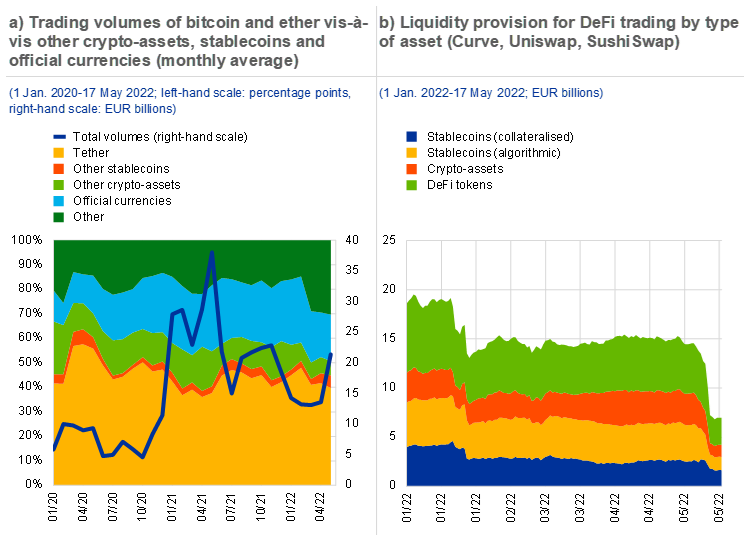11 Jul 2022 Jane Whitmoore
Stablecoins Are In The Spotlight Of EU Regulators Due To Their Rapid Growth
Stablecoins turned out to be having a much stronger role than initially anticipated, since some existing stablecoins play a critical role in terms of liquidity of the crypto-asset markets, like Tether.
The European Central Bank (ECB)’s “Stablecoins’ role in crypto and beyond: functions, risks, and policy” report highlights the role of stablecoins in mainstream finance due to their “rapid growth, increasing global use cases, and potential financial risk contagion channels.”
The ECB research paper also addresses the possible financial stability implications of stablecoins stemming from their current role in the crypto-asset ecosystem.
It turns out that in the past couple of years, stablecoins managed to become a safer alternative to crypto volatility, and the emergence of the DeFi sector further emphasized that importance. However, according to the research, “stablecoins account for only a small part of the total crypto-asset market, but the largest ones have assumed a critical role within the crypto-asset ecosystem.”
Indeed, the market capitalization of stablecoins increased from €23 billion in early 2021 to just under €150 billion in the first quarter of 2022, but that is below 10% of the entire market cap of the crypto sector. The leaders in the stablecoin market are Tether, USD Coin, and Binance USD, which account for almost 90% of the stablecoin market, especially after the May 9 TerraUSD market crash, which wiped out almost its entire market capitalization.
Furthermore, Tether is still the dominant stablecoin and has already become critical in crypto-asset trading, since it is functioning as a bridge between fiat currencies and cryptos.

Source: European Central Bank
Stablecoins as means of payment
According to the ECB report, stablecoins still have a long way to go before being eligible to be accepted as a true means of payment for the real economy. It turns out that one of the biggest reasons behind stablecoins not being used as a payment method is the regulatory uncertainty in the light of adopting the Markets in Crypto-assets (MiCA) Regulation. Furthermore, only a few service providers that deal with stablecoins are registered as payment service providers.
Another key setback for stablecoin adoption is the slow transaction speeds that Tether, for example, is seeing on the Ethereum blockchain. However, in order for stablecoins to be considered as a true means of payment, the speed of transaction has to be much faster. Nevertheless, the much-anticipated Ethereum transition to proof-of-stake could resolve some of the throughput issues the Ethereum blockchain is currently experiencing.
Are stablecoins a risk to financial stability?
The ECB also denoted several risks behind the use of stablecoins in the form of liquidity issues, and transparency, despite the transparency of reserve asset composition having increased in the past 12 months. Furthermore, the TerraUSD market crash and the Tether de-pegging have proven that stablecoins are anything but stable, resulting in massive outflows.
The TerraUSD crash outlined why the stablecoin market has to be regulated, especially when taking into consideration the cross-border nature of stablecoins. The de-pegging has led to increased attention from EU regulators, with ECB claiming that the EU’s proposed MiCA Regulation needs to be implemented urgently.
“The MiCA Regulation is a bespoke framework for the issuance and provision of services related to stablecoins and other crypto-assets. Under this regulation, stablecoin issuers and crypto-asset service providers are subject to the same set of minimum requirements, irrespective of their applicable licensing regime.” the ECB added.
Crypto Market central banks crypto market monitoring cryptocurrency news Stablecoin Europe Stablecoins Regulations





























